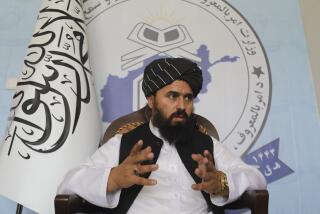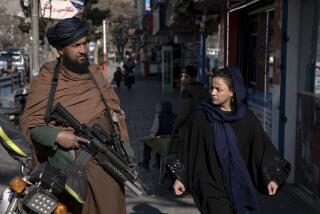Photos of U.S. soldiers posing with Afghan corpses prompt condemnation
From the White House to the American Embassy in Kabul, American officials rushed to distance themselves from the actions of U.S. soldiers who posed for photographs next to corpses and body parts of Afghan insurgents.
Two photos of incidents from a 2010 deployment were published Wednesday by the Los Angeles Times. In one, the hand of a corpse is propped on the shoulder of a paratrooper. In another, the disembodied legs of a suicide bomber are displayed by grinning soldiers and Afghan police.
Secretary of DefenseLeon E. Panettaapologized for the photographs, saying the behavior depicted in the photos “absolutely violates both our regulations and, more importantly, our core values. This is not who we are.... If rules and regulations were found to have been violated, then those individuals will be held accountable.”
White House Press Secretary Jay Carney called the soldiers’ behavior “reprehensible,” and said President Obama wanted a full investigation.
The NATO commander in Afghanistan, U.S. Gen. John Allen, and American Ambassador Ryan Crocker, who were alerted that the photos were coming, condemned the actions even before the photos were published online. Allen said U.S. officials were working with Afghan and international forces “to resolve any issues related to improper treatment of remains.” Crocker called the actions of soldiers in the photos “morally repugnant.”
At the same time, Pentagon and White House officials expressed disappointment that the photos had been made public. The Pentagon had asked The Times not to publish the photos, citing fears that they would trigger a backlash against U.S. forces.
Speaking to reporters during a meeting of NATO allies in Brussels, Panetta said:
“This is war. And I know that war is ugly and violent. And I know that young people sometimes caught up in the moment make some very foolish decisions. I am not excusing that behavior. But neither do I want these images to bring further injury to our people or to our relationship with the Afghan people.”
Davan Maharaj, editor of The Times, said the newspaper considered a Pentagon appeal to delay publication, and decided to hold off for more than 72 hours until military officials said they had taken security precautions against any retaliation.
“At the end of the day, our job is to publish information that our readers need to make informed decisions,” Maharaj said in an online discussion Wednesday. “We have a particular duty to report vigorously and impartially on all aspects of the American mission in Afghanistan.”
He added: “On balance, in this case, we felt that the public interest here was served by publishing a limited but representative sample of these photos, along with a story examining the circumstances under which they were taken.”
After the newspaper provided several photos to military officials last month, theU.S. Armybegan an investigation, saying the soldiers’ actions violated Army standards. The photos were among 18 images of soldiers posing with corpses or body parts. They were provided to The Times by a soldier who served in Afghanistan with the 82nd Airborne Division in 2010.
The soldier who provided the photos said he and others in an 82nd Airborne brigade were concerned about a lack of discipline, leadership and security that he said compromised soldiers’ safety — and he cited the photos as one example.
He expressed the hope that publication would help ensure that alleged security shortcomings at two U.S. bases in Afghanistan in 2010 were not repeated. The brigade, under new command but with some of the same paratroopers who served on a yearlong deployment in 2010, began another tour in Afghanistan in February.
There were no immediate reports of violence in Afghanistan in response to the photos. Many Afghans, especially those in rural areas, do not have Internet access or electricity. The country’s main evening news broadcasts did not show the photos.
Suicide bombers and insurgents who plant roadside bombs are widely despised by Afghans. Civilians are routinely killed or maimed by insurgents who detonate suicide vests or set out homemade bombs that kill indiscriminately.
A recent United Nations report said the Taliban and other insurgent groups were responsible for 77% of fatal attacks against civilians last summer, most of them from suicide bombs or roadside explosives.
Still, the taboo against desecration of the dead is strong in this religiously conservative country.
“We condemn Americans posing with dead bodies or body parts,” said Najla Dehqan Nezhad, a member of parliament from the western province of Herat.
Farhad Mohammed, a merchant in the southern city of Kandahar, said of the 2-year-old photos: “Nothing has changed since then, and nothing will. Always it is a matter of disrespect.”
The Taliban made no initial statement, although the group generally exploits such incidents for propaganda purposes.
Two experts said the photos may have more effect on public opinion in the United States than in Afghanistan.
Andrew Exum, a former Army officer and scholar at the Center for a New American Security, said the photos’ effect on Afghans’ opinions would probably be “pretty low” compared with some of the actions taken by other U.S. troops in their country, including the inadvertent burning of Korans at a U.S. base.
But the pictures probably would upset many Americans, and would raise uncomfortable questions about the mental health of the troops and the cohesiveness of their fighting units, he said.
“Americans are going to care a lot more about these pictures than the Afghans,” said Exum, who served in Afghanistan and Iraq.
Peter Feaver, a former official in theGeorge W. Bushadministration and a Duke University scholar on the military, said the photos had “the potential to do more damage to public and coalition support for the war than to Afghan attitudes.”
He said there had been a series of incidents by U.S. troops and others that had shaken faith in the war. “Each of them is a setback in the war of ideas, and they can accumulate,” he said.
He said that although the photos “shock the conscience,” other acts, such as those that humiliated Afghans and “fed into the narrative of anti-Islamic bigotry,” could do more damage.
Zucchino reported from Durham, N.C., and King from Kabul, Afghanistan. Paul Richter contributed to this report from Washington, D.C., and David S. Cloud from Brussels.
More to Read
Get the L.A. Times Politics newsletter
Deeply reported insights into legislation, politics and policy from Sacramento, Washington and beyond. In your inbox three times per week.
You may occasionally receive promotional content from the Los Angeles Times.











